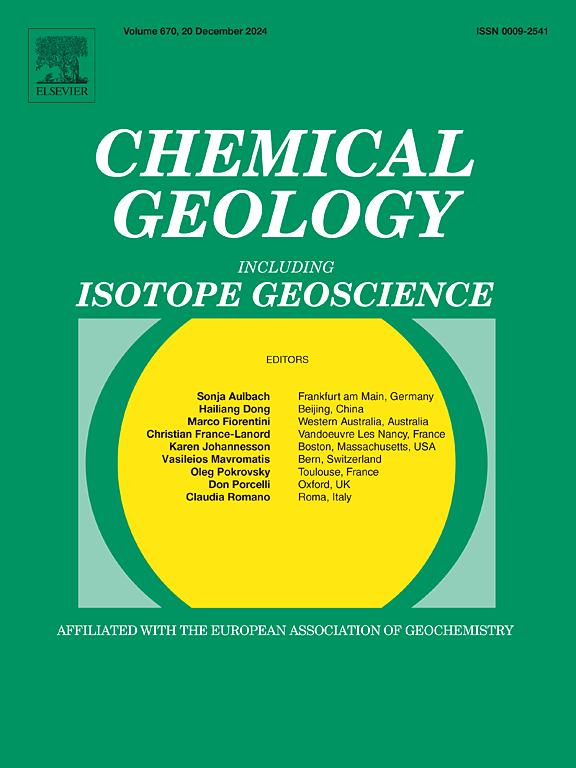Reactivity of chlorite and gneiss from ONKALO (Western Finland): Laboratory experiments and reactive transport modeling
IF 3.6
2区 地球科学
Q1 GEOCHEMISTRY & GEOPHYSICS
引用次数: 0
Abstract
The Finnish geological repository for spent nuclear fuel is being constructed at the ONKALO® underground facility in Olkiluoto Island. The bedrock is mainly migmatitic gneiss, including brittle fault zones where groundwater flows. An important process is the dissolution of chlorite, which releases Fe(II) that can lead to FeS precipitates and regulate dissolved HS− concentrations. Elevated HS− concentrations could induce corrosion of the copper canisters containing the spent fuel.
Two powder chlorite samples from faults in the gneiss and provided by Posiva Oy (Finnish nuclear waste management company) were characterized. They contained both muscovite and chlorite. Laboratory batch and flow-through experiments were performed to study the solubilities and dissolution reaction rates of the chlorite (and muscovite) samples. The results were consistent with previous results reported in the literature.
Two core-infiltration experiments were also performed, using a gneiss sample containing a fracture (also provided by Posiva Oy). The results were interpreted by means of one- and two-dimensional reactive transport models. The 1D model included flow, solute transport and reaction only along the fracture. It needed unrealistically large mineral surface areas to reproduce the experimental results. In addition to the fracture, the 2D model included transport by diffusion in the rock matrix, with mineral reactions in both fracture and matrix. With this approach the large surface areas in the fracture were no longer needed, highlighting the reactivity of the rock matrix despite the small porosities (about 1 %) and diffusivities. The calculated dissolution of chlorite could indeed release Fe(II) under repository conditions.
来自ONKALO(芬兰西部)的绿泥石和片麻岩的反应性:实验室实验和反应输运模型
芬兰的乏核燃料地质储存库正在奥尔基洛托岛的ONKALO®地下设施中建造。基岩主要为混染片麻岩,包括地下水流动的脆性断裂带。一个重要的过程是绿泥石的溶解,它释放出Fe(II), Fe(II)可以导致FeS沉淀并调节溶解的HS -浓度。高HS−浓度会引起含有乏燃料的铜罐的腐蚀。由芬兰核废料管理公司Posiva Oy提供的两个片麻岩断层的绿泥石粉末样品进行了表征。它们含有白云母和绿泥石。通过实验室批量和流动实验研究了绿泥石(和白云母)样品的溶解度和溶解反应速率。结果与先前文献报道的结果一致。还进行了两次岩心渗透实验,使用含有裂缝的片麻岩样品(也由Posiva Oy提供)。用一维和二维反应输运模型对结果进行了解释。一维模型只考虑沿断口的流动、溶质输运和反应。要重现实验结果,需要非常大的矿物表面积。除了裂缝,二维模型还包括岩石基质中的扩散输运,裂缝和基质中都有矿物反应。采用这种方法,不再需要裂缝中的大表面积,尽管孔隙率(约1%)和扩散率很小,但突出了岩石基质的反应性。在储存库条件下,计算出的绿泥石溶解度确实能释放出铁(II)。
本文章由计算机程序翻译,如有差异,请以英文原文为准。
求助全文
约1分钟内获得全文
求助全文
来源期刊

Chemical Geology
地学-地球化学与地球物理
CiteScore
7.20
自引率
10.30%
发文量
374
审稿时长
3.6 months
期刊介绍:
Chemical Geology is an international journal that publishes original research papers on isotopic and elemental geochemistry, geochronology and cosmochemistry.
The Journal focuses on chemical processes in igneous, metamorphic, and sedimentary petrology, low- and high-temperature aqueous solutions, biogeochemistry, the environment and cosmochemistry.
Papers that are field, experimentally, or computationally based are appropriate if they are of broad international interest. The Journal generally does not publish papers that are primarily of regional or local interest, or which are primarily focused on remediation and applied geochemistry.
The Journal also welcomes innovative papers dealing with significant analytical advances that are of wide interest in the community and extend significantly beyond the scope of what would be included in the methods section of a standard research paper.
 求助内容:
求助内容: 应助结果提醒方式:
应助结果提醒方式:


